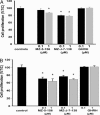Effective treatment of experimental human non-Hodgkin's lymphomas with antagonists of growth hormone-releasing hormone
- PMID: 16027368
- PMCID: PMC1180787
- DOI: 10.1073/pnas.0504102102
Effective treatment of experimental human non-Hodgkin's lymphomas with antagonists of growth hormone-releasing hormone
Abstract
Antagonists of growth hormone-releasing hormone (GHRH) were shown to inhibit the growth of various cancers. We investigated the antitumor activity and the mechanism of action of GHRH antagonists in human non-Hodgkin's lymphomas (NHL). Nude mice bearing xenografts of RL and HT human NHL were treated with GHRH antagonists MZ-5-156 and MZ-J-7-138 at a dose of 40 microg twice daily. The concentrations of serum IGF-1 and GHRH, bFGF, and VEGF in tumor tissue were measured by radioimmunoassays. Expression of GHRH and splice variant 1 of the GHRH receptor in both cell lines was examined by RT-PCR. The effects of MZ-5-156, MZ-J-7-138 and GHRH on cell proliferation were evaluated in vitro. Treatment with MZ-5-156 and MZ-J-7-138 significantly (P < 0.05) inhibited the growth of RL and HT tumors by 59.9-73.9%. High-affinity binding sites for GHRH and mRNA for GHRH and splice variant-1 of the GHRH receptors were found on RL and HT tumors. RL and HT cells contained GHRH peptide, and their growth in vitro was significantly inhibited by both antagonists. IGF-I levels in serum of mice were significantly decreased by antagonist MZ-5-156. Therapy with GHRH antagonists also significantly reduced tumoral bFGF, whereas VEGF levels were not suppressed. Our findings suggest that GHRH antagonists inhibit the growth of RL and HT lymphomas by direct effects mediated by tumoral receptors for GHRH. GHRH antagonists could offer a new therapeutic modality for the management of advanced NHL.
Figures




Similar articles
-
Dose-dependent growth inhibition in vivo of PC-3 prostate cancer with a reduction in tumoral growth factors after therapy with GHRH antagonist MZ-J-7-138.Prostate. 2008 Dec 1;68(16):1763-72. doi: 10.1002/pros.20843. Prostate. 2008. PMID: 18729085
-
Antagonists of growth hormone releasing hormone (GHRH) and of bombesin/gastrin releasing peptide (BN/GRP) suppress the expression of VEGF, bFGF, and receptors of the EGF/HER family in PC-3 and DU-145 human androgen-independent prostate cancers.Prostate. 2005 Aug 1;64(3):303-15. doi: 10.1002/pros.20262. Prostate. 2005. PMID: 15754342
-
Inhibition of growth of experimental human endometrial cancer by an antagonist of growth hormone-releasing hormone.J Clin Endocrinol Metab. 2005 Jun;90(6):3614-21. doi: 10.1210/jc.2004-2179. Epub 2005 Mar 22. J Clin Endocrinol Metab. 2005. PMID: 15784701
-
Antagonists of growth-hormone-releasing hormone: an emerging new therapy for cancer.Nat Clin Pract Endocrinol Metab. 2008 Jan;4(1):33-43. doi: 10.1038/ncpendmet0677. Nat Clin Pract Endocrinol Metab. 2008. PMID: 18084344 Review.
-
Endocrine and antineoplastic actions of growth hormone-releasing hormone antagonists.Curr Med Chem. 2008;15(4):314-21. doi: 10.2174/092986708783497355. Curr Med Chem. 2008. PMID: 18288987 Review.
Cited by
-
Synergistic inhibition of growth of lung carcinomas by antagonists of growth hormone-releasing hormone in combination with docetaxel.Proc Natl Acad Sci U S A. 2006 Sep 26;103(39):14513-8. doi: 10.1073/pnas.0605309103. Epub 2006 Sep 18. Proc Natl Acad Sci U S A. 2006. PMID: 16983095 Free PMC article.
-
A novel approach for the treatment of AML, through GHRH antagonism: MIA-602.Rev Endocr Metab Disord. 2025 Jun;26(3):483-491. doi: 10.1007/s11154-024-09917-6. Epub 2024 Oct 17. Rev Endocr Metab Disord. 2025. PMID: 39417961 Free PMC article. Review.
-
Growth hormone-releasing hormone and cancer.Rev Endocr Metab Disord. 2025 Jun;26(3):443-456. doi: 10.1007/s11154-024-09919-4. Epub 2024 Oct 18. Rev Endocr Metab Disord. 2025. PMID: 39422787 Review.
-
GHRH and the prostate.Rev Endocr Metab Disord. 2025 Jun;26(3):467-481. doi: 10.1007/s11154-024-09922-9. Epub 2024 Nov 7. Rev Endocr Metab Disord. 2025. PMID: 39505776 Review.
-
The development of growth hormone-releasing hormone analogs: Therapeutic advances in cancer, regenerative medicine, and metabolic disorders.Rev Endocr Metab Disord. 2025 Jun;26(3):385-396. doi: 10.1007/s11154-024-09929-2. Epub 2024 Nov 26. Rev Endocr Metab Disord. 2025. PMID: 39592529 Free PMC article. Review.
References
-
- Jemal, A., Murray, T., Ward, E., Samuels, A., Tiwari, R. C., Ghafoor, A., Feuer, E. J. & Thun, M. J. (2005) CA Cancer J. Clin. 55, 10-30. - PubMed
-
- Freedman, A. S. (2004) in Cancer Medicine, eds. Kufe, D. W., Weichselbaum, R. R., Bast, R. C., Jr., Gansler, T. S., Holland, J. F. & Frei, E., III (B.C. Decker, Hamilton, Canada), pp. 2189-2210.
-
- The International Non-Hodgkin's Lymphoma Prognostic Factors Project (1993) N. Engl. J. Med. 329, 987-994. - PubMed
-
- Schally, A. V. & Comaru-Schally, A. (2003) in Cancer Medicine, eds. Kufe, D. W., Pollock, R. E., Weichselbaum, R. R., Bast, R. C., Jr., Gansler, T. S., Holland, J. F. & Frei, E., III (B.C. Decker, Hamilton, Canada), pp. 911-926.
Publication types
MeSH terms
Substances
LinkOut - more resources
Full Text Sources
Miscellaneous

